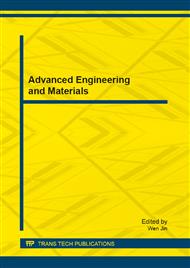[1]
T.H. Hsu, L.H. Shiao, C. Hsieh, D.M. Chang, A comparison of the chemical composition and bioactive ingredients of the Chinese medicinal mushroom DongChongXiaCao, its counterfeit and mimic, and fermented mycelium of Cordyceps sinensis, Food Chem. 78 (2002).
DOI: 10.1016/s0308-8146(02)00158-9
Google Scholar
[2]
Y.L. Liang, Y. Liu, J.W. Yang, C.X. Liu, Studies on pharmacological activities of cultivated Cordyceps sinensis, Phytother. Res. 11 (1997) 237-239.
Google Scholar
[3]
S. Wang, F.Q. Yang, K. Feng, D.Q. Li, J. Zhao, S.P. Li, Simultaneous determination of nucleosides, myriocin, and carbohydrates in Cordyceps by HPLC coupled with diode array detection and evaporative light scattering detection, J. Sep. Sci. 32 (2009).
DOI: 10.1002/jssc.200900570
Google Scholar
[4]
S.P. Li, P. Li, T.T. Dong, K.W. Tsim, Determination of nucleosides in natural Cordyceps sinensis and cultured Cordyceps mycelia by capillary electrophoresis, Electrophoresis 22 (2001) 144-150.
DOI: 10.1002/1522-2683(200101)22:1<144::aid-elps144>3.0.co;2-t
Google Scholar
[5]
F.Q. Yang, L. Ge, J.W. Yong, S.N. Tan, S.P. Li, Determination of nucleosides and nucleobases in different species of Cordyceps by capillary electrophoresis-mass spectrometry, J. Pharm. Biomed. Anal. 50 (2009) 307-314.
DOI: 10.1016/j.jpba.2009.04.027
Google Scholar
[6]
F.Q. Yang, D.Q. Li, K. Feng, D.J. Hu, S.P. Li, Determination of nucleotides, nucleosides and their transformation products in Cordyceps by ion-pairing reversed-phase liquid chromatography-mass spectrometry, J. Chromatogr. A 1217 (2010) 5501-5510.
DOI: 10.1016/j.chroma.2010.06.062
Google Scholar
[7]
H. Yang, B. Kuang, A.M. Mouazen, In situ determination of growing stages and harvest time of tomato (Lycopersicon esculentum) fruits using fiber-optic visible-near-infrared (Vis-NIR) spectroscopy, Appl. Spectrosc. 65 (2011) 931-938.
DOI: 10.1366/11-06270
Google Scholar
[8]
H. Yang, B. Kuang, A.M. Mouazen, Quantitative analysis of soil nitrogen and carbon at a farm scale using visible and near infrared spectroscopy coupled with wavelength reduction, Eur. J. Soil Sci. 63 (2012) 410-420.
DOI: 10.1111/j.1365-2389.2012.01443.x
Google Scholar
[9]
C.C. Lau, C.O. Chan, F.T. Chau, D.K. Mok, Rapid analysis of Radix puerariae by near-infrared spectroscopy, J. Chromatogr. A 1216 (2009) 2130-2135.
DOI: 10.1016/j.chroma.2008.12.089
Google Scholar
[10]
C.Y. Wang, B.R. Xiang, W. Zhang, Application of two-dimensional near-infrared (2D-NIR) correlation spectroscopy to the discrimination of three species of Dendrobium, J. Chemometr. 23 (2009) 463-470.
DOI: 10.1002/cem.1237
Google Scholar
[11]
Y.W. Wu, S.Q. Sun, Q. Zhou, H.W. Leung, Fourier transform mid-infrared (MIR) and near-infrared (NIR) spectroscopy for rapid quality assessment of Chinese medicine preparation Honghua Oil, J. Pharm. Biomed. Anal. 46 (2008) 498-504.
DOI: 10.1016/j.jpba.2007.11.021
Google Scholar
[12]
P. Yang, P. Song, S.Q. Sun, Q. Zhou, S. Feng, J.X. Tao, Differentiation and quality estimation of Cordyceps with infrared spectroscopy, Spectroc. Acta Pt. A-Molec. Biomolec. Spectr. 74 (2009) 983-990.
DOI: 10.1016/j.saa.2009.09.004
Google Scholar
[13]
N. Xu, X. Wei, B. Ren, Y. He, L. Feng, Near-Infrared Spectroscopy Analysis of Adenosine and Water in Fermentation Cordyceps Powder and Wavelength Assignment, Spectroscopy and Spectral Analysis 32 (2012) 1762-1765.
Google Scholar
[14]
M.E. Timmerman, H.A.L. Kiers, Three-mode principal components analysis: Choosing the numbers of components and sensitivity to local optima, British Journal of Mathematical and Statistical Psychology 53 (2000) 1-16.
DOI: 10.1348/000711000159132
Google Scholar
[15]
A. Ciampi, F.L. Zhang, A new approach to training back-propagation artificial neural networks: empirical evaluation on ten data sets from clinical studies, Stat. Med. 21 (2002) 1309-1330.
DOI: 10.1002/sim.1107
Google Scholar
[16]
S.P. Li, F.Q. Yang, K.W. Tsim, Quality control of Cordyceps sinensis, a valued traditional Chinese medicine, J. Pharm. Biomed. Anal. 41 (2006) 1571-1584.
DOI: 10.1016/j.jpba.2006.01.046
Google Scholar


